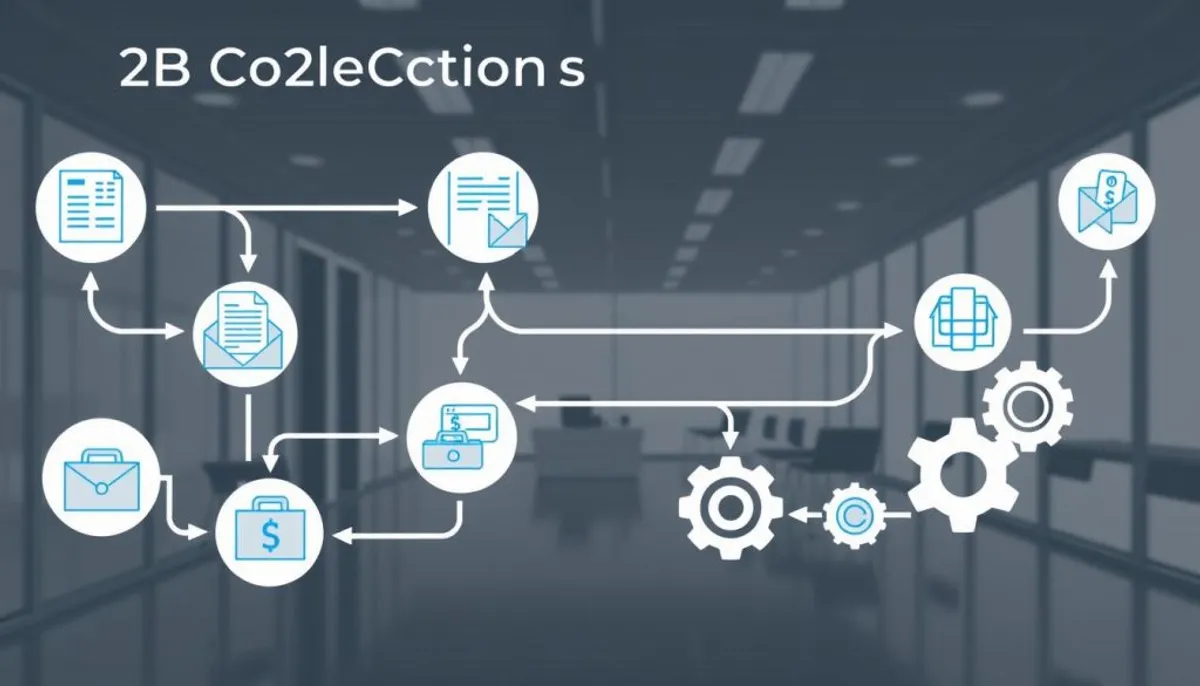In the realm of business, the flow of cash is paramount. B2B collections are instrumental in ensuring this flow remains uninterrupted. They focus on retrieving funds owed between businesses for goods or services rendered. Unlike consumer collections, B2B transactions involve intricate agreements and substantial sums.
Effective management of accounts receivable is critical for a company’s financial stability. It guarantees timely payments while fostering positive business relationships. A structured collections process offers a framework for handling overdue payments with professionalism and efficiency.

Adopting astute debt recovery strategies can significantly impact a business. These strategies may include early intervention, transparent communication, and adaptable payment arrangements. By leveraging appropriate tools and methodologies, enterprises can enhance their cash flow and alleviate financial burdens.
Key Takeaways
- B2B collections involve professional relationships and larger transactions
- Timely invoicing and payment tracking are essential for effective collections
- Communication and flexible payment plans help maintain business relationships
- Technology tools can streamline the accounts receivable process
- Proactive solutions like late fees and incentives can address late payments
- Regular reviews of collection strategies improve their effectiveness
Understanding B2B Collections and Their Importance
B2B collections are essential for maintaining healthy business relationships and financial stability. This process involves recovering payments between companies, often for substantial transactions with extended credit terms. It’s vital to explore the core aspects of B2B collections and their significance.
Definition and Core Components
B2B collections involve strategies and actions to recover payments from other companies. These efforts include proactive communication, follow-up procedures, and escalation processes. Commercial debt collection demands a balance between assertiveness and professional relationship maintenance.
Impact on Business Financial Health
Effective delinquent payment resolution is crucial for sustaining cash flow, a business’s lifeblood. Unpaid invoices can disrupt working capital, strain operations, and hinder growth opportunities. Implementing robust B2B collection practices helps companies:
- Ensure timely payment of employees
- Invest in business expansion
- Meet financial obligations
- Maintain a healthy cash flow
Key Differences from B2C Collections
B2B collections differ significantly from B2C collections in several ways:
| Aspect | B2B Collections | B2C Collections |
|---|---|---|
| Transaction Size | Larger amounts | Smaller amounts |
| Relationship | Long-term partnerships | Short-term interactions |
| Legal Framework | Not governed by FDCPA | Governed by FDCPA |
| Decision-Making | Complex, multiple stakeholders | Single consumer |
Understanding these distinctions is crucial for developing effective commercial debt collection strategies. These strategies must preserve business relationships while ensuring timely payments.
Modern Challenges in Commercial Debt Recovery
In today’s fast-paced business environment, B2B payment processing encounters significant hurdles. Companies face intricate legal complexities, notably when transacting with international entities. The communication divide between creditors and debtors frequently results in misinterpretations and delayed remittances.
Given the evolving business landscape, credit risk mitigation has emerged as a critical concern. Businesses must adopt more robust strategies to safeguard their financial health. They must navigate these challenges while upholding professional integrity and ethical standards.
Debt recovery agencies are leveraging AI and machine learning to forecast payment behaviors and automate collection tactics. This technological advancement streamlines the b2b payment processing process. Concurrently, these agencies prioritize compliance management to ensure all collection activities adhere to current legal frameworks.
| Challenge | Solution |
|---|---|
| Communication gaps | AI-powered prediction tools |
| International legal issues | Cross-border collection expertise |
| Regulatory compliance | Automated compliance management |
| Risk assessment | Early intervention strategies |
Modern debt collectors play a pivotal role, extending beyond mere financial recovery. They are actively involved in legal proceedings and counsel businesses on fortifying client agreements. This strategy aids in mitigating credit risks and fosters enduring business partnerships.
Streamlining Accounts Receivable Management
Effective accounts receivable management is vital for maintaining a healthy cash flow and minimizing financial risk. Implementing smart strategies and leveraging technology can optimize the collections process. This, in turn, improves overall financial performance.
Implementing Automated Systems
Dunning process automation revolutionizes accounts receivable management. Automating invoicing, reminders, and escalation procedures reduces errors and ensures timely follow-ups. AR automation software can decrease cash collection time by up to 80%, enhancing efficiency significantly.
Creating Efficient Payment Workflows
Collections workflow optimization involves streamlining the payment process. This includes offering flexible payment options and early payment discounts. Switching to electronic invoicing facilitates easy online payments and efficient record-keeping. Clear credit and collection policies help avoid overdue accounts and streamline the workflow.

Monitoring and Reporting Tools
Utilizing advanced analytics and reporting tools is essential for tracking key performance indicators. These include Days Sales Outstanding (DSO), Average Days Delinquent (ADD), and the Collection Effectiveness Index (CEI). Aim for a DSO below 30 days and a CEI close to 100% for optimal performance.
| Metric | Target | Impact |
|---|---|---|
| Days Sales Outstanding (DSO) | Below 30 days | Faster payment collection |
| Collection Effectiveness Index (CEI) | Above 80% | Improved collection efficiency |
| AR Automation | 80% time reduction | Enhanced operational efficiency |
By focusing on these key areas, businesses can significantly improve their accounts receivable management. This leads to faster collections, enhanced customer satisfaction, and increased profitability.
Professional Debt Recovery Strategies
Effective b2b collections necessitate a strategic framework. Businesses can refine their debt recovery endeavors while preserving positive relationships with delinquent clients. Let’s examine pivotal strategies to augment your collection initiatives.
Early Intervention Techniques
Timely action is paramount in b2b collections. Engage with clients before payments are overdue. Dispatch clear reminders and offer support. This preemptive strategy can avert minor issues from escalating into significant problems.
Communication Best Practices
Clear, consistent communication is indispensable. Employ diverse channels to follow up with clients. Be professional and empathetic. Your objective is to recover funds while safeguarding business relationships. Effective communication can notably enhance delinquent customer retention.
Negotiation Approaches
Flexibility is essential in debt recovery. Propose payment plans for clients facing financial hardships. This strategy can facilitate successful b2b collections while preserving goodwill. Be amenable to compromise, yet ensure agreements are explicit and documented.
- Set clear payment terms
- Monitor accounts receivable closely
- Act promptly on overdue payments
- Use diplomatic approaches to maintain relationships
- Consider professional debt recovery agencies for complex cases
By adopting these strategies, businesses can enhance their b2b collections process. This methodology not only aids in debt recovery but also fosters delinquent customer retention, ensuring enduring business prosperity.
Technology Integration in Collections Process
The B2B collections landscape is undergoing a significant transformation, driven by technology integration. Companies are adopting digital solutions to enhance their collections workflow. Notably, 78% of B2B entities now employ subscription-based billing models, facilitating smoother recurring payments.
Electronic invoicing has transformed b2b payment processing, increasing efficiency by 60%. This transition not only accelerates transactions but also diminishes errors. The introduction of payment portals and self-service options has reduced overhead costs by 30%, enabling businesses to reallocate resources more efficiently.
Mobile payment solutions for B2B collections have experienced a 45% growth, accommodating the dynamic nature of contemporary business. Blockchain technology is also gaining traction, reducing conflicts and scams in B2B transactions by 25%.
- AI and machine learning drive data-based collection plans
- Global debt collection market to reach $19.4 billion by 2032
- BGO brings 40 years of experience to B2B collections
AI-powered AR solutions are revolutionizing B2B credit and collections. They process extensive data instantly, enhancing credit assessments and collection efficiency. Speech analytics and AI-driven customer profiling lead to more effective digital interactions throughout the collection lifecycle.
By harnessing these technological advancements, businesses can streamline collection efforts, minimize bad debts, reduce costs, and enhance customer experience in B2B collections operations.
Introducing ti3: Revolutionary Collections Platform
The ti3 platform is revolutionizing delinquent payment resolution. It offers a software-as-a-service solution that simplifies managing overdue accounts. This innovation brings efficiency and ease to a previously complex process.
Platform Features and Benefits
ti3 boasts a comprehensive suite of tools for streamlining collections. Its user-friendly interface empowers businesses to monitor payments, send reminders, and escalate issues from a single platform. This makes it a cost-effective alternative to traditional debt collection agencies.
Automation Capabilities
ti3’s core feature is its dunning process automation. It can:
- Send timely payment reminders
- Escalate overdue accounts automatically
- Generate detailed reports on collection efforts
These capabilities save businesses time and resources, enhancing collection rates. The automation in ti3 aligns with the digital transformation trend in enterprises, as observed in studies of small and medium-sized firms.
Customer Relationship Preservation
ti3 prioritizes maintaining positive customer relationships during collections. It allows businesses to communicate professionally and consistently with clients. This approach helps preserve long-term partnerships, even when addressing overdue payments. It underscores the importance of relationship marketing in today’s digital business environment.
Legal Considerations and Compliance
B2B collections demand meticulous adherence to legal and regulatory frameworks. Though less stringent than B2C debt collection, businesses must still navigate intricate compliance landscapes. The Uniform Commercial Code (UCC) regulates most commercial transactions, including b2b collections practices.
Regulatory Framework
Diverse states impose specific licensing requirements for commercial debt collection. Industries handling payment information must adhere to the Payment Card Industry Data Security Standard (PCI DSS). Partnering with agencies holding SOC 2 Type II certification ensures strict compliance adherence.
Documentation Requirements
Proper documentation is paramount in b2b collections. Businesses must keep records of all communications and agreements. Secure client portals and regular compliance audits safeguard sensitive data. Automation is crucial for standardizing communication and minimizing errors.
Risk Management Protocols
Effective risk management in commercial debt collection necessitates ongoing staff training, regular process reviews, and updates to comply with evolving laws. Understanding statutes of limitations and regional licensing requirements is vital to avoid legal issues. Businesses often outsource to specialized agencies after invoices are 90 days past due, leveraging their higher success rates over internal teams.
| Compliance Aspect | Importance | Best Practice |
|---|---|---|
| Legal Standards | Crucial | Regular legal updates |
| Privacy Laws | High | Secure data management |
| Communication Regulations | Essential | Standardized protocols |
| Staff Training | Vital | Ongoing education |
Building Effective Collection Workflows
Streamlining accounts receivable management is essential for businesses to maintain a healthy cash flow. By focusing on collections workflow optimization, companies can significantly enhance their debt recovery processes. An effective workflow includes clear payment terms, prompt follow-ups, and professional communication.
Establishing transparent payment terms with customers, including due dates and late fees, helps prevent collection issues. Quick follow-ups when payments are missed demonstrate the seriousness of debt collection. Maintaining professionalism in all communications is key to preserving customer relationships.
To enhance your collections process, consider these steps:
- Set up automated invoice generation and reminders
- Offer various online payment options
- Implement collections software for efficient task management
- Use multi-channel reminders to ensure prompt contact with debtors
- Provide flexible payment plans to facilitate timely settlements
By leveraging automation and specialized tools, businesses can streamline their collections workflow, reducing manual tasks and improving efficiency. This approach not only saves time but also minimizes errors in the debt recovery process.
| B2B Collections Challenges | Solutions |
|---|---|
| Complex payment terms | Clear communication and documentation |
| Longer payment cycles | Proactive follow-ups and reminders |
| Multiple stakeholders | Targeted communication strategies |
| Large transaction volumes | Automated workflow systems |
Implementing these strategies in your collections workflow optimization can lead to improved accounts receivable management and better overall financial health for your business.
Maintaining Customer Relationships During Collections
B2B collections present a delicate challenge. The goal is to recover debts without jeopardizing business relationships. This balance is essential for retaining delinquent customers and ensuring long-term success.

Professional Communication Strategies
In b2b collections, clear and respectful communication is paramount. Employ proactive invoicing and courteous reminders to keep clients abreast. Establishing clear terms from the outset helps prevent misunderstandings. It’s noteworthy that 84% of businesses overlook automating their AR systems, leading to unnecessary complications.
Conflict Resolution Methods
When conflicts emerge, the focus should be on finding mutually beneficial solutions. Consider these strategies:
- Offer flexible payment options
- Utilize mediation services before resorting to legal action
- Seek to understand the debtor’s perspective
- Negotiate settlements to mitigate relationship strain
Long-term Relationship Management
Preserving business relationships during debt recovery is paramount. Businesses that offer flexible payment plans tend to maintain positive client relationships. Implementing an up-to-date online portal facilitates easy account management. Regular updates and transparent reports foster trust and contribute to successful outcomes.
Measuring Collections Success
Effective accounts receivable management and b2b collections necessitate a data-driven methodology. By monitoring key performance indicators, enterprises can assess the efficacy of their collection tactics and pinpoint areas for enhancement.
Days Sales Outstanding (DSO) is a critical metric, reflecting the average duration for customers to settle invoices. A diminished DSO signifies expedited payment collection. The Collection Effectiveness Index (CEI) is equally essential, quantifying an organization’s capacity to collect total receivables.
The Right Party Contacts (RPC) rate gauges the success in directly contacting debtors. This metric, in conjunction with the Percentage of Outbound Calls Resulting in Promise to Pay (PTP), evaluates the efficacy of communication tactics in b2b collections.
Financial health indicators encompass the Profit per Account (PPA) and Bad Debt Loss Percentage. These metrics offer insights into the profitability of collection endeavors and the overarching risk management in accounts receivable management.
| Metric | Description | Formula |
|---|---|---|
| Days Sales Outstanding (DSO) | Average time to collect payment | (Accounts Receivable / Total Credit Sales) × Number of Days |
| Collection Effectiveness Index (CEI) | Ability to collect receivables | (Total Cash Collected / Total Outstanding Receivables) × 100% |
| Bad Debt Loss Percentage | Percentage of uncollectible debt | (Total Bad Debt Write-offs / Total Credit Sales) × 100% |
Through consistent analysis of these metrics, businesses can refine their b2b collections strategies. This enables the maintenance of robust customer relationships and enhances overall financial well-being.
Conclusion
Effective b2b collections are vital for maintaining financial stability and optimizing cash flow. Businesses face challenges like time-consuming processes and legal pitfalls. Partnering with specialized agencies like ACS can be transformative. These experts provide customized strategies, ensuring legal compliance and preserving valuable customer relationships.
Modern accounts receivable management has evolved significantly. It now incorporates technological advancements such as data analytics, chatbots, and automation tools. These innovations streamline debt interactions and enhance the overall collection experience. Multi-channel communication methods have become essential, offering debtors flexibility and improving recovery rates.
In today’s global marketplace, international b2b collections require expertise in cross-cultural communication and navigating complex legal landscapes. Debt recovery strategies now focus on a customer-centric approach, balancing firm financial goals with relationship management. By leveraging professional services and advanced technologies, businesses can overcome collection challenges, accelerate cash flow, and focus on core operations for long-term success.
RelatedRelated articles



